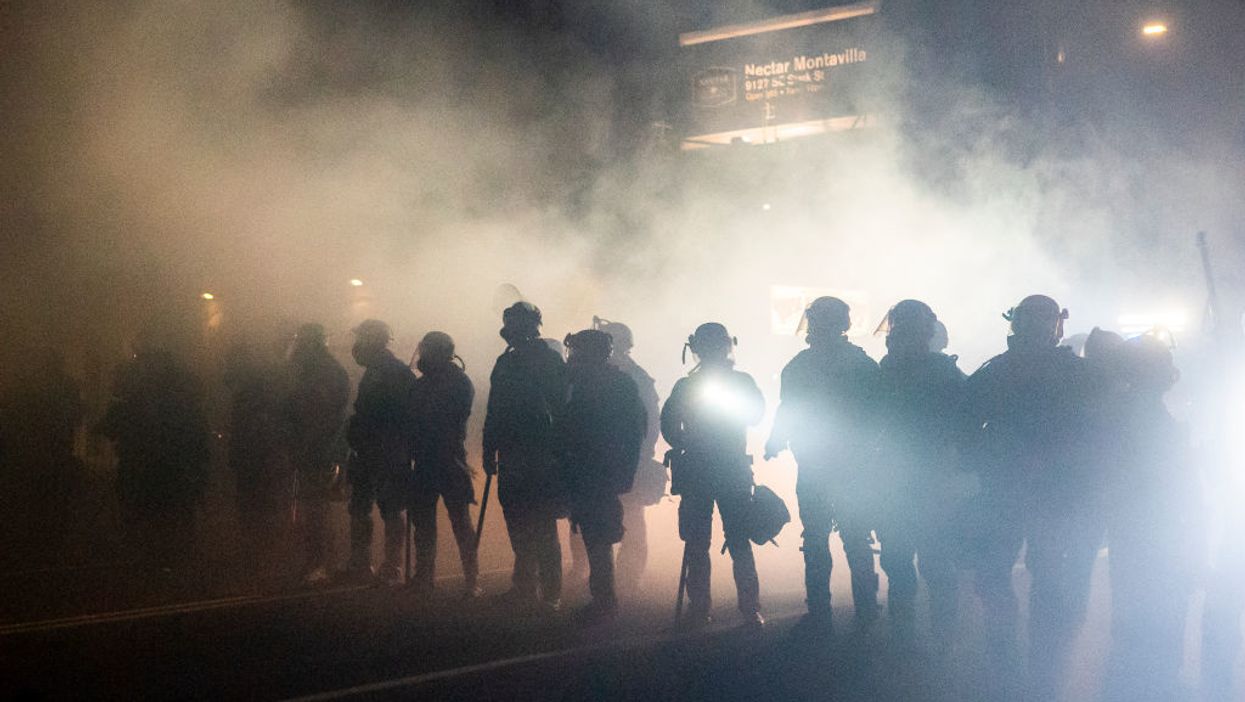
Nathan Howard/Getty Images

The NYT finally discovered anarchists that spent the summer destroying American cities
Photojournalist Jeremy Lee Quinn was furloughed this year, so he set out to document the protests and the riots that beset cities across the U.S. following the death of George Floyd. Quinn expected to discover white supremacists caused havoc and violence at riots, but what he actually found shocked him — violent left-wing anarchists who were extremely organized.
On May 31, Quinn covered a Black Lives Matter protest in Santa Monica, California, where "suburban moms" were kneeling. Then he was alerted to a shoe store being looted about a mile away.
"He arrived to find young people pouring out of the store, shoeboxes under their arms. But there was something odd about the scene," Farah Stockman wrote in the New York Times. "A group of men, dressed entirely in black, milled around nearby, like supervisors. One wore a creepy rubber Halloween mask."
The next day, Quinn went to another protest, and another store was being looted. A white man wearing all black smashed the window of the store with a crowbar, but he walked away without stealing anything.
Quinn started pouring over footage of looting that was happening across the country. Once again, he noticed that white men dressed in black were often the culprits of the looting.
Quinn believed that the caucasian men causing damage were white supremacist supporters of President Donald Trump, who were attempting to make Black Lives Matter protests appear in a negative light. In an effort to expose the alleged racist Trump supporters, Quinn went undercover and infiltrated the groups. Instead, he found that these destructive forces were "true believers in insurrectionary anarchism."
Over the next four months, Quinn marched along with "black bloc anarchists in half a dozen cities across the country." He was in Washington D.C., where militant agitators harassed diners, and in Portland where rioters launched fireworks at the Mark O. Hatfield Federal Courthouse.
"He says he respects the idealistic goal of a hierarchy-free society that anarchists embrace, but grew increasingly uncomfortable with the tactics used by some anarchists, which he feared would set off a backlash that could help get President Trump re-elected."
Quinn told the New York Times that the far-left anarchists were not "a spontaneous eruption of anger at racial injustice," like much of the mainstream media categorized the violence as. "It was strategically planned, facilitated and advertised on social media by anarchists who believed that their actions advanced the cause of racial justice."
Quinn cautioned that the violent militants in Washington, Portland, and Seattle generated a "cultlike energy."
Quinn saw something else he did not expect to see during the protests, Black Lives Matter protesters praying together with Trump supporters in Tulsa.
Quinn detailed his experience during protests and riots on his website, Public Report, where he warned how dangerous far-left anarchist groups could be.
"Establishment media still continues to overlook trending Anarchist black bloc tactics especially in DC, Portland & Seattle with satellite activity in Denver, Sacramento and San Diego," Quinn wrote. "Insurrectionary Anarchist ideology & rhetoric however has permeated into the social justice movement with blazing efficiency."
"In our experience in Louisville, Community was strong and gravitating towards non violent protest," he wrote. "Earlier in the afternoon we saw individual protesters shutting down agitators trying to use fireworks. But the arrival of a U-Haul with Anarcho / Antifascist symboled shields changed everything."
Many of the left-wing extremists consider themselves "insurrectionary anarchists," some of which "advocate using crimes like arson and shoplifting to wear down the capitalist system."
The NYT article cites a report by Rutgers researchers that documents the "systematic, online mobilization of violence that was planned, coordinated (in real time) and celebrated by explicitly violent anarcho-socialist networks that rode on the coattails of peaceful protest." The research found that some anarchist social media accounts had exploded 300-fold since May, garnering hundreds of thousands of followers.
Stockman explained the problem with making alliances with insurrectionary anarchists.
"If they help you get into power, they will try to oust you the following day, since power is what they are against," she wrote. "Many of them don't even vote. They are experts at unraveling an old order but considerably less skilled at building a new one. That's why, even after more than 100 days of protest in Portland, activists do not agree on a set of common policy goals."
"We are not sure if the socialist, communist, democratic or even anarchist utopia is possible," admitted a host of the anarchist-supporting podcast "The Ex-Worker." "Rather, some insurrectionary anarchists believe that the meaning of being an anarchist lies in the struggle itself and what that struggle reveals."
Stockman hints that the far-left anarchists are not truly destroying American cities to declare that black lives matter or demand racial equality, but because they crave anarchy and their mission is to topple the status quo.